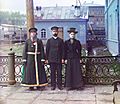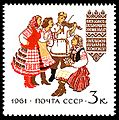East Slavs facts for kids

Countries with predominantly East Slavic population
|
|
| Total population | |
|---|---|
| 200+ million | |
| Regions with significant populations | |
| Majority: Belarus, Russia, Ukraine Minority: Baltics (Estonia, Latvia, Lithuania), Serbia, Caucasus (Azerbaijan, Georgia), Moldova, other former Soviet states. |
|
| Languages | |
| East Slavic languages: Belarusian, Russian, Rusyn, Ukrainian |
|
| Related ethnic groups | |
| Other Slavs |
The East Slavs are a group of Slavic people. They speak languages like Belarusian, Russian, Rusyn, and Ukrainian.
Long ago, they were the main people living in an early powerful state called Kievan Rus'. By the 1600s, these groups grew into the people we know today as Belarusians, Russians, Rusyns, and Ukrainians.
The Story of the East Slavs
We don't know much about the early East Slavs before the year 859 AD. This is when the first events were written down in an important old book called the Primary Chronicle.
The East Slavs from these very early times did not have a written language. So, they didn't write down their own history. What we do know comes from a few places:
- Archaeology: This is the study of old things people left behind, like tools or buildings.
- Travelers' stories: People from other lands visited and wrote about the Rus' land.
- Language studies: Experts compare old Slavic languages to learn about their past.
Very few original writings from the Rus' people before the 10th century have survived. The Primary Chronicle is the oldest major book with information about Rus' history. It was written much later, between the late 1000s and early 1100s.
This chronicle lists twelve Slavic groups who lived in the area that became Kievan Rus' by the 900s. This land was between the Western Bug River, the Dnieper River, and the Black Sea. These tribes included:
- The Polans
- The Drevlyans
- The Dregovichs
- The Radimichs
- The Vyatichs
- The Krivichs
- The Slovens
- The Dulebes (who later became known as the Volhynians and Buzhans)
- The White Croats
- The Severians
- The Ulichs
- And the Tivertsi
Images for kids
-
Three generations of a Russian family, around 1910
-
Belarusians in traditional dress
-
Ukrainians in traditional dress
-
Russians in traditional dress from the Vologda region
-
A Bread and salt greeting ceremony in Vladivostok, Russia
-
A bread and salt greeting ceremony in Kyiv, Ukraine
See also
 In Spanish: Eslavos orientales para niños
In Spanish: Eslavos orientales para niños









